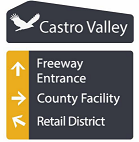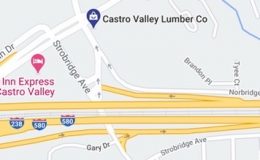Great information to have.. The default response from the county too often is that all public assets in our town are “the county’s” versus local resident’s. Would that we could still use this method to finance capital projects for the public good. Much better than the “borrow now, stick the next generation with the tab” revenue bonds that are the only way to go in the Prop. 13 era.
How We Built the Old Castro Valley Library


One of the more popular conversation topics around town is “what the heck is going on with the old library building?” The Castro Valley MAC was asking the same thing of the County at the September 21st MAC meeting.
Caroline Judy, the acting head of the Alameda County GSA (the county agency tasked with building and property control) gave a quick update on the current state of the building and what repairs and upgrades the County feels the facility needs. According to Judy, required upgrades are needed to the heating/cooling systems, restrooms and electrical systems as well as repairs to some windows and skylights.
Currently the building is being used for storage of fixtures and supplies for the Alameda County Library, and they have no current plans for other uses or sale of the site. MAC Chair Marc Crawford asked for clarification on the ownership status of the site. It has long been remarked around Castro Valley that the library was paid for by the citizens of Castro Valley through a tax. Judy replied that their research showed that the facility was paid for directly out of the County general fund, but she would do further research.
This begs the question, just who did pay for that library? Well, I’ve found the answer and it is quite a story!
How it all began…
The Castro Valley Library dates back to 1927 and its story is befitting of our town’s poultry pedigree. Before the Redwood Road location was built in 1962 the library lived in a 900-square-foot converted chicken house. In 1957 Mrs. Pauline Vierra, a local mother and concerned citizen, got together with branch librarian Clara Cathey. They both agreed that the library was nowhere near good enough for the growing town and started a grassroots campaign for better facilities.
The campaign grew large enough that the long-forgotten Castro Valley Recreation Council sponsored a public meeting on the topic at Chabot Elementary. At the meeting, Supervisor Francis Dunn explained ways that a new Castro Valley Library could be built. He proposed creating a County Service Area (CSA) and appoint a local advisory committee. The CSA could then levy a property tax to help pay for a new branch.
Other ideas were also floated such as an elected Library Service District — an idea championed by local winemaker Paul Rhodes who also led the Castro Valley Fire District. Rhodes also preferred the idea of having the County buy the firehouse at the corner of Redwood and Heyer from the cash-strapped district and convert it into a new library and lobbied hard for that to happen. He later was able to sell it to Redwood Christian Church. (Ironically, Rhodes later became a member of the Castro Valley Unified School District Board, and spoke publicly against the sale of school district land to the Fire Department in the late 1970’s to build Fire Station #6 on Cull Canyon Road. At the time he said one arm of government should not profit from another…)

Eventually the citizenry decided to go with the CSA plan. In early 1958, a six person advisory council was appointed by Supervisor Dunn and the Castro Valley Library County Service Area CSA-L-1 was created by the Board of Supervisors. The advisory board recommended to the Board of Supervisors that the CSA levy a property tax on residents of the CSA area at a rate of 10 cents per $100 of assessed value for three years to fund half the price of a new facility. They also suggested that the County use sales tax revenues to pay for the other half.
The Board of Supervisors took the advice, but made the property tax levy a five year plan instead of three. The tax brought in roughly $27,000 per year to the County general fund. The sales tax idea proved to be a bit more of a stickier issue. Under California law in 1958, sales tax revenues from unincorporated areas could not be specifically used to fund a library project like that.
 The law had to be changed, and Castro Valley Assemblyman Carlos Bee (who just happened to be the Speaker of the State Assembly at the time) wrote up Assembly Bill AB 1916 to legalize that funding plan and introduced it on March 10th. With blinding speed, the bill made it through the legislature and was signed by Governor Brown (the original one) on May 23rd, 1958. Half of the new library would be paid for via the property tax for five years on local residents, and the other half would be paid for with sales tax revenues raised from the unincorporated areas of the County — not exclusively from Castro Valley.
The law had to be changed, and Castro Valley Assemblyman Carlos Bee (who just happened to be the Speaker of the State Assembly at the time) wrote up Assembly Bill AB 1916 to legalize that funding plan and introduced it on March 10th. With blinding speed, the bill made it through the legislature and was signed by Governor Brown (the original one) on May 23rd, 1958. Half of the new library would be paid for via the property tax for five years on local residents, and the other half would be paid for with sales tax revenues raised from the unincorporated areas of the County — not exclusively from Castro Valley.

The advisory committee did extensive research and eventually advised the Board to hire the local firm of Wahamaki and Corey to design the new branch. (Other notable local buildings they designed include the Castro Valley Community Center, and Our Lady of Grace Church.) A one acre plot of land was purchased on Redwood Road for $28,000, the existing house there was sold by the County for $500 and it was moved to a vacant lot across the street from the High School. Construction commenced, and the new library with its striking mid-century design opened in 1962.
During the grand opening festivities, Supervisor Dunn announced that the grand total for the entire project was $309,260 and had been completely paid for by the local tax, and sales tax revenues from the unincorporated areas. The building served the town well for the next 46 years before being replaced by our fabulous new branch on Norbridge. After levying the property tax for five years, the CSA ceased to function, and laid dormant until the County finally dissolved it in 2008.

So, while the County is technically correct in saying that the building was paid for out of the County general fund, it is also true that $309,260 was put into that fund directly by the residents of Castro Valley (and some other unincorporated shoppers,) specifically to build that building.
Whatever becomes of the site in its new life, I hope the County and library keeps that in mind.
Michael Baldwin also serves on the Alameda County Library Advisory Commission representing Castro Valley.


